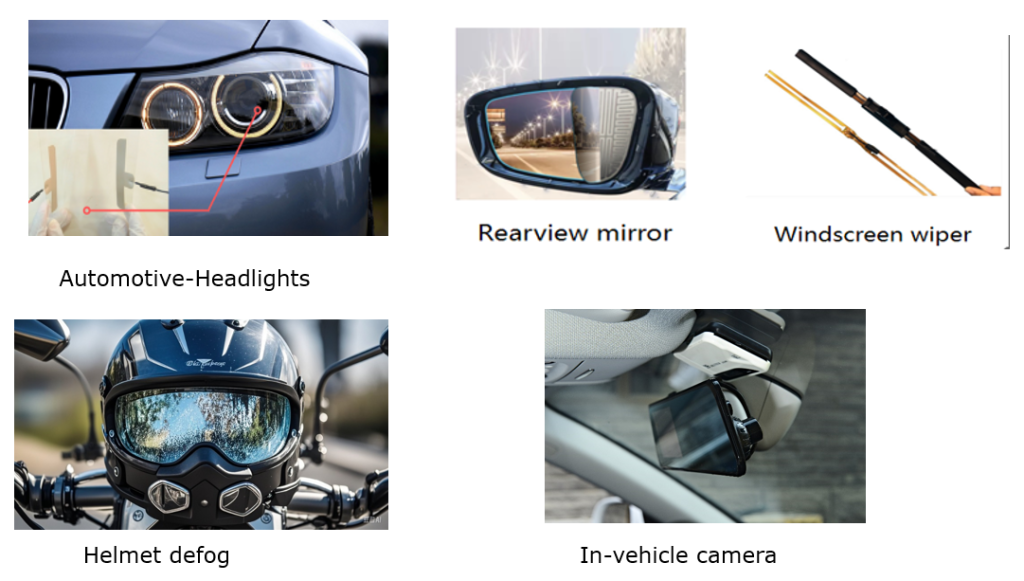Have you ever noticed your car’s skylight fogging up on a cold morning or freezing in winter? This common issue can reduce visibility and comfort. Transparent heating film for warming skylights offers an advanced solution—combining optical clarity with efficient heating to keep skylights clear, warm, and safe.
This technology integrates a thin conductive layer into transparent film, generating gentle heat when powered. It prevents condensation, defrosts ice, and enhances passenger comfort without compromising transparency. Let’s explore how it works, its benefits, and where it’s commonly applied.

A transparent heating film is a thin, flexible, electrically conductive layer laminated onto or between glass substrates. When a voltage is applied, the film converts electrical energy into thermal energy, heating the surface evenly.
Unlike traditional heating wires, which can be visible and uneven, these films are optically clear, maintaining transparency above 85–90%. The most common structures include:
This technology merges optics, electronics, and material science into one simple-looking but high-performance component.
The operating principle is based on Joule heating (Q = I²R). When current flows through the film’s conductive layer, resistance causes energy to dissipate as heat. The heat spreads across the surface and warms the skylight.
In vehicles, a control circuit monitors power input and temperature feedback. It adjusts the voltage and current to ensure optimal heating without overheating.
Typical technical parameters:
This rapid and even heating helps maintain clear glass visibility under extreme weather conditions.

The integration process involves several technical steps:
The result is a fully transparent, electrically functional skylight with consistent heating behavior and long service life. If you order a transparent heater from Danyu electronics, our team can guide you to install a heater to your skylight glass step by step.
Efficiency depends on resistance uniformity, voltage input, and film thickness. A well-designed film can reach defrost temperatures within minutes with minimal power draw.
For example:
Moreover, thermal uniformity avoids cold spots that cause partial fogging. This makes transparent heating films particularly suitable for electric vehicles, where battery conservation is crucial.

Yes. High-quality heating films maintain 85–95% optical transmittance, nearly identical to untreated glass. Advanced nanostructured coatings minimize reflection and haze, preserving natural daylight.
Some films even integrate UV filtering or IR reflection layers to enhance thermal comfort and protect interiors from sunlight degradation.
Yes. The heating pattern, resistance value, and transparency can be tailored to each vehicle model. Curved panoramic roofs, tinted skylights, or even integrated solar panels can all be designed around transparent heating layers.
Manufacturers can adjust parameters such as:
Durability depends on the coating quality and lamination process. Properly designed films can last over 10 years or 100,000+ heating cycles without visible degradation.
Protective overcoats and laminated glass encapsulation prevent oxidation and moisture intrusion. Automotive-grade testing includes:
These validations guarantee reliability in real-world conditions.
1. How much power does a transparent heating film consume?
Power consumption ranges between 30–150W depending on film size and vehicle voltage, much lower than traditional air-based defrost systems.
2. Can transparent heating films be tinted or combined with UV filters?
Yes, they can integrate UV-cut layers or color tints without affecting heating performance or transparency.
3. Is the heating film visible from inside the car?
No. The conductive layer is microscopic, maintaining full transparency even under direct sunlight.
4. What voltage is typically used in automotive heating films?
Most systems use 12V or 24V for conventional vehicles, while electric or commercial vehicles may use up to 48V.
5. Can transparent heating films be repaired if damaged?
Minor damage can sometimes be patched, but severe defects usually require replacing the laminated glass unit for safety and consistency.
Simply drop your email or phone number in the contact form, and we'll promptly reply you shortly.